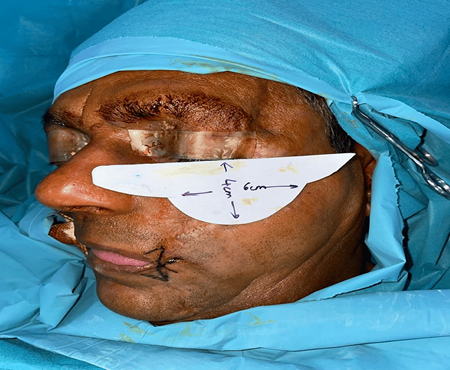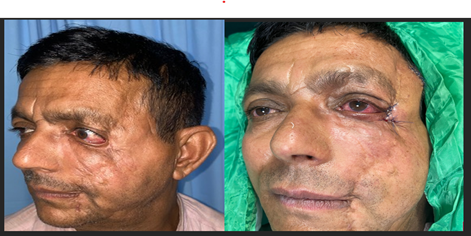MOJ
eISSN: 2381-179X


Case Report Volume 14 Issue 3
Department of Burns & Plastic surgery, All India Institute of Medical Sciences, India
Correspondence: Debarati Chattopadhyay, Additional Professor, Department of Burns & Plastic Surgery, All India, Institute of Medical Sciences, Rishikesh, Uttarakhand, India
Received: July 22, 2024 | Published: August 5, 2024
Citation: Singh T, Chattopadhyay D, Kapoor A, et al. Tensor fascia lata graft with fat graft used as a wrist watch sling for ectropion release in a complex facial scar. MOJ Clin Med Case Rep. 2024;14(3):59-60. DOI: 10.15406/mojcr.2024.14.00464
The face is a vital structure with uttermost importance aesthetically and functionally. Complex facial scar is a surgical challenge due to scarred and fibrotic surrounding tissue with unpredictable healing. We describe a case of a 50-year-old male with multiple times operated scars over his face. In this technique, we used dermis fat grafting attached to tensor fascia lata designed as a wristwatch. The tensor facia lata was designed as a dial of a watch which was attached on both sides by dermis fat graft like a wristband. Both tissues were used in a single stage to manage an intractable complex facial scar with ectropion. There were no significant complications post-operatively.
Keywords: complex face scar, tensor fascia lata, fat graft, ectropion, trauma, aesthetic reconstruction
Face is the most identifiable aspect of an individual’s personality. It is of uttermost importance aesthetically and functionally.1 Thus scars over the face can be physically and psychologically disabling. An ideal reconstruction of a complex facial scar should have favourable colour, texture, thickness and contour matching the surrounding skin.2 Complex scar along with ectropion is even more difficult to manage. Multiple surgeries to resurface these scars invariably leave surrounding tissue more fibrotic and scarred with unpredictable healing.3 Various reconstructive options to treat complex scarring include local and distant flaps and free fat grafting.4 Whereas tensor fascia lata graft has been used as a template to correct the eyelid defect during eyelid reconstruction.5 In the described case we combined both these reconstructive options to manage a recalcitrant complex scarring of the face with ectropion.
A 50-year-old male presented with a history of road traffic accidents Four years back. The accident led to multiple variable thickness lacerations to the left side cheek and lower eyelid with abrasions all over the left cheek region. As a result, the patient had to undergo multiple surgeries in the emergency. The procedures included free tissue transfer, local flaps and canthopexies. This has resulted in severely scarred skin on the left side face with cicatricial left lower eyelid ectropion. The overlying texture of the skin was rough with areas of fibrotic and thinned-out skin. Therefore, the right cheek and surrounding area of the right lower eyelid rendered very little local tissue for reconstructive purposes as seen in Figure 1. The patient was explained about the procedure and appropriate consent was taken. An endocrine opinion was sought for uncontrolled diabetes and the patient was started on Insulin. Blood investigations were done. Fitness was obtained from the anaesthetic department.

Figure 1 Post-traumatic complex facial scar showing scarred skin over left side face with left lower eyelid ectropion with the depressed scar over left malar region.
General anaesthesia was given and the patient was positioned in a supine position. The required volume was estimated by marking the depressed scar as shown in Figure 2. The right anterolateral thigh is marked in the shape of a watch. The dial represents the area where tensor fascia lata (TFL) will be harvested and bands represent the surrounding dermo fat. (Figure 3) A sub-ciliary incision was made to reach the tarsal plate. The surrounding scarred tissue was released to free form the underlying soft tissue. The scarred tissue was excised. In the thigh standard vertical incision was made to harvest tensor fascia lata and a circular amount of skin and fat was harvested along with the fascia lata. (Figure 4) The skin over the marked tissue of the band was de-epithelized to form a composite dermis fat fascia graft resembling a wristwatch. (Figure 4) The dermis fat was inserted in the region of the scarred cheek while the TFL was attached to the left nasal ala on one side through the left lower eyelid to attach to the lateral orbital. This allowed the tissue to fill the cheek volume providing a smooth contour. Lateral canthopexy was done at the end of the procedure.

Figure 2 preoperative planning showing a lateral view of the depressed scar with the overlying blueprint of the donor tissue which will be inserted..

Figure 4 The left figure shows the preoperative photograph of the complex facial scar with left lower eyelid ectropion causing difficulty in closing eyes and visible contour deformity figure on the right shows a post-operative follow-up photograph showing improved contour with correction of lower eyelid ectropion with fullness in the left cheek region..
Unfavourable complex facial scar leads to physical as well as psychological disfigurement. Due to surrounding fibrous tissue and scarring these scars need to be reoriented to lie within 30 degrees of relaxed skin tension lines.2 Conventional reconstructive procedures can be used to correct the deformities but do not provide good aesthetic results at the same time.4 In this case, several challenges need to be addressed while planning the procedure. Firstly, there was a bad scar surrounding the eyelid due to previous surgeries. Therefore, local tissue transfer was not feasible. Secondly, along with the scar, the contour deformity had to be corrected. Subsequently, the overall texture of the skin had to be improved to provide acceptable aesthetics. The patient being a diabetic was prone to wound dehiscence and surgical site infections. The template was made on the lateral aspect of the right thigh in the shape of the watch. The Tensor fascia lata was to be incised in the shape of a dial of a wristwatch with a dermis fat graft attached on both sides to the Tensor fascia lata as bands of a watch. This whole arrangement was used to reconstruct the scar. The satisfactory result was visible immediately in the postoperative period with complete closure of left eyelids with smooth contour visible after two weeks post-operatively. All problems due to complex scars were corrected in one stage with a very good outcome. There were no significant complications noted.
Our technique aimed to improve the contour and texture of a complex facial scar. This can be achieved using tensor fascia lata and dermis fat grafts from the same donor area without significant complications. Thus, we can address a complex facial scar in a single stage.
None.
The authors declare that there is no conflicts of interest.

©2024 Singh, et al. This is an open access article distributed under the terms of the, which permits unrestricted use, distribution, and build upon your work non-commercially.